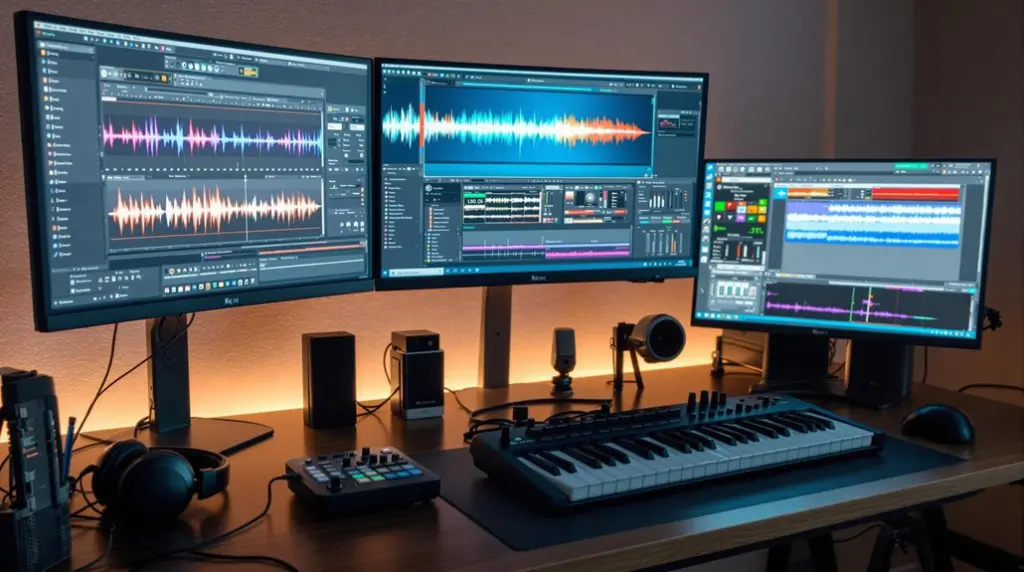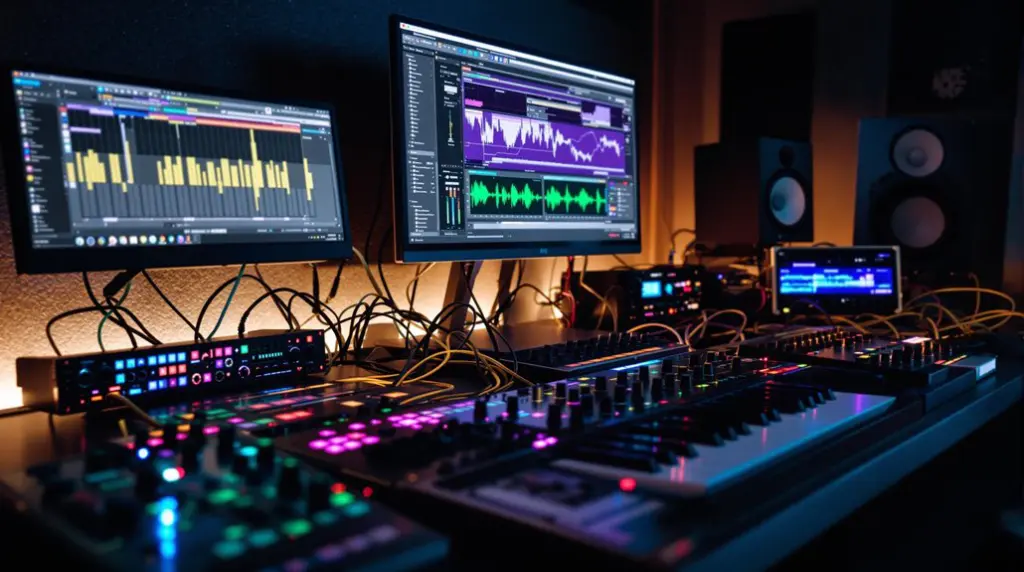The U-he Zebra 2 VST excels with its modular synthesis environment, delivering a hardware-like system that offers extensive sound creation possibilities. Featuring exceptionally low CPU usage, users can run multiple instances without performance issues, making it ideal for complex soundscapes. The modulation matrix is another highlight, providing 12 slots for extensive parameter modulation, complemented by a versatile LFO module. These standout features, combined with a user-friendly interface and detailed tutorial resources, make Zebra 2 an exemplary choice for sound designers. Discovering even more details about its capabilities will further showcase how it meets professional audio production needs.
Key Takeaways
- Zebra 2’s modular synthesis environment offers versatile sound creation.
- Low CPU usage allows multiple instances without performance degradation.
- The modulation matrix with 12 slots enables extensive parameter modulation.
- An extensive preset library provides thousands of free presets for inspiration.
- The Perform Panel with four X/Y pads allows simultaneous control of multiple parameters.
Overview and Usability
When it comes to the overview and usability of U-he Zebra 2, one immediately notices its user-friendly interface, which is augmented by customizable skins that not only enhance the visual appeal but also improve the user experience. The ability to adjust the interface size from 70% to 200% guarantees that users can tailor the display to fit various screen sizes and accommodate different patch complexities.
This level of interface customization is particularly beneficial for those who work with intricate sound designs and require a clear and accessible layout. Featuring thorough tutorials and educational content, Zebra 2 supports users by providing resources that cover both basic and advanced functionalities.
The preset browser is another standout feature, organized methodically into categories to facilitate quick access to desired sounds. This simplistic yet efficient design eliminates the need for extensive navigation, allowing users to focus more on creativity and less on searching for presets.
Additionally, the modular synthesis environment mimics hardware modular systems, providing a versatile and thorough platform for sound creation.
Supporting users of all skill levels, Zebra 2 includes extensive documentation and tutorial videos. These resources are invaluable for both novices and seasoned professionals, guaranteeing that everyone can effectively utilize the synthesizer’s robust functionalities.
Sound Design Capabilities
Building upon the robust usability features, Zebra 2’s sound design capabilities showcase its true potential as a versatile synthesizer. The incorporation of both additive synthesis and spectral synthesis allows musicians and sound designers to craft an extensive array of sounds, ranging from crystal-clear tones to darker, more complex textures.
Zebra 2’s adaptive interface enhances the user experience by dynamically displaying only active modules, thereby streamlining navigation and focusing creativity on sound design. The intuitive design also supports waveform modulation techniques, ensuring users can create intricate textures and tones effortlessly.
Key components that underscore Zebra 2’s sound design prowess include:
- Comb Module: This feature facilitates physical modeling synthesis effects, providing an additional layer of depth and realism to sound creation.
- XMF Module: The Cross Modulation Filter (XMF) allows for intricate sound manipulation through combined filters, greatly enhancing stereo imaging and overall sound complexity.
- Additive Synthesis: Enables fine-grained control over harmonics, allowing users to sculpt sounds with precision and clarity.
- Spectral Synthesis: Offers advanced manipulation of frequency components, enabling the creation of evolving, dynamic timbres.
- Extensive Preset Library: Thousands of free presets available online serve as a valuable resource for inspiration and quick access to diverse sounds.
This synthesis flexibility, combined with a user-friendly interface, positions Zebra 2 as a formidable tool in any sound designer’s arsenal.
Modulation and Effects
Zebra 2’s modulation and effects capabilities greatly enhance its status as a professional synthesizer, providing sound designers with an extensive toolkit for dynamic sound shaping. Central to this is the thorough modulation matrix, which features 12 slots. This allows users to extensively modulate various parameters across sound generators, employing advanced modulation techniques for intricate and evolving textures.
For those looking to blend genres within their soundscapes, Zebra 2 offers unparalleled flexibility.
The synthesizer’s LFO Module provides eight distinct waveforms, facilitating the creation of cyclic movements and vibrato. Complementing this is the LFOG Module, which retains waveform selection without per-voice retriggering, making it ideal for global modulation applications.
Additionally, the ENV Module offers syncable and loopable ADSR controls, enabling precise shaping of sound dynamics over time, essential for detailed sound design.
Zebra 2 also excels in effects customization. The built-in effects engine permits two effects per patch, equipped with intuitive knobs for swift adjustments. The radar sweep display visually illustrates parameter changes, aiding users in making informed tweaks.
Moreover, the Perform Panel, with its four X/Y pads, allows for simultaneous control of multiple parameters, offering a powerful interface for expressive live performances and intricate sound manipulation.
Performance and Flexibility
Zebra 2 excels in live playability, providing musicians with complete control over synthesizer parameters without needing samples, consequently offering enhanced performance flexibility.
Its modular design enables users to intuitively create and manipulate complex patches, streamlining the workflow for both novice and experienced sound designers.
Additionally, Zebra 2’s low CPU usage compared to alternatives like Serum permits multiple instances to run concurrently, ensuring efficient performance even in larger, resource-intensive projects.
This makes it an ideal choice for producers seeking both powerful functionality and system efficiency.
Live Playability Highlights
Live playability is a key asset for any performance tool, and U-he’s Zebra 2 excels in this domain by offering a robust array of features designed to enhance on-the-fly sound manipulation.
Musicians can leverage Zebra 2’s capabilities to achieve unparalleled levels of live improvisation and performance enhancements, guaranteeing a dynamic and engaging experience.
Key highlights include:
- Modular Design: Zebra 2’s modular nature allows users to reconfigure patches quickly, providing the flexibility to adapt to evolving musical contexts during live sessions.
- MIDI Learn Functionality: This feature enables performers to assign controls to external hardware effortlessly, facilitating seamless integration into live setups and guaranteeing real-time control.
- Low CPU Usage: Efficient resource management allows multiple instances of Zebra 2 to run simultaneously, accommodating complex live arrangements without compromising system performance.
- Intuitive Interface: The user-friendly interface, coupled with customizable skins, guarantees easy navigation and rapid adjustments, essential for maintaining flow during performances.
- No Pre-recorded Samples: By enabling musicians to manipulate sounds directly, Zebra 2 eliminates reliance on pre-recorded samples, thereby enhancing performance flexibility and spontaneity.
Modular System Efficiency
The seamless integration of a wireless modular design in U-he’s Zebra 2 greatly enhances both performance and flexibility, making it a powerhouse for sound designers and live performers alike. This design allows for efficient patch management, enabling users to create and modify complex patches with ease.
The intuitive interface promotes quick creation and experimentation, allowing users to focus on auditory skills rather than being bogged down by visual feedback. This results in a more immersive and productive sound design process.
Zebra 2’s signal routing capabilities are another standout feature, providing unparalleled flexibility. Users can effortlessly route signals between various modules, integrating external effects to expand the sonic possibilities further.
This level of control is essential for dynamic sound creation, especially in live performance scenarios where adaptability is key. The synthesizer’s fully resizable GUI, ranging from 70% to 200%, caters to different screen sizes and user preferences, enhancing usability during intricate sound design tasks.
Low CPU Usage
Given its remarkable efficiency, U-he Zebra 2 stands out for its exceptionally low CPU usage, which allows users to run multiple instances without greatly impacting system performance. This characteristic makes it a preferred choice for complex projects where numerous tracks and effects are commonplace.
The synthesizer’s design prioritizes audio efficiency, enabling extensive sound design capabilities without overwhelming the system’s resources. Compared to other popular synthesizers like Serum, Zebra 2’s processing efficiency is particularly superior.
Its modular design not only supports intricate patch creation but also guarantees consistent system stability, making it a prime tool for both studio and live performance environments. Users frequently report that even during demanding sessions, Zebra 2 maintains performance without lag or slowdowns.
Its low CPU footprint offers several advantages:
- Enhanced resource management: Prime use of system resources allows for more creative flexibility.
- Stability in complex projects: Run multiple instances without risking performance degradation.
- Ideal for live scenarios: Maintains responsiveness, essential for live performances.
- Extended sound design: Supports intricate and layered soundscapes without taxing the CPU.
- Comparative efficiency: Outperforms many synthesizers in maintaining system performance.
Learning Resources
When diving into the intricate world of sound design with U-he Zebra 2, the availability of robust learning resources greatly enhances the user experience. Abundant tutorials on platforms like YouTube and ADSR provide in-depth sound design techniques suitable for both beginners and advanced users.
These tutorial platforms offer a structured path to mastering Zebra 2’s functionalities, ensuring effective and efficient learning. Additionally, resources recommended by ADSR and Groove3 are instrumental in enhancing the user’s knowledge and understanding of Zebra 2. Although some limitations exist in depth for advanced techniques, these resources lay a strong foundation for intermediate users to build upon.
For those focusing on genre-specific sound design, exploring custom devices can considerably enhance creativity.
The active user community plays a pivotal role in continuous learning, with members frequently sharing presets and tips. High interaction statistics on various discussion forums underscore the value of community engagement, fostering a collaborative environment that is rich in ongoing learning opportunities.
Furthermore, extensive user guides provide essential tips for effective usage and sound design, while continuous community engagement through newsletters and updates keeps users informed about new techniques and sound design possibilities. This culture of learning and exploration is vital for maximizing the potential of U-he Zebra 2.
Purchase Considerations
When considering the purchase of Zebra 2, prospective users will find its one-time purchase model and competitive pricing particularly appealing, especially in contrast to subscription-based alternatives.
The inclusion of a trial version offers a risk-free evaluation period, while the free upgrade to Zebra 3 for Dark Zebra purchasers guarantees future-proofing and ongoing innovation.
Additionally, Zebra 2’s broad compatibility across major platforms assures seamless integration into various production environments.
Integrating quality mastering plugins within Zebra 2 can greatly enhance dynamic range control and overall sound enhancement.
Its user-friendly interface, akin to popular mastering software like iZotope Ozone, simplifies the sound design process, solidifying its status as a versatile and valuable tool for sound designers and producers.
Pricing and Upgrades
While evaluating the pricing and upgrade options for U-he Zebra 2, it’s clear that this synthesizer offers a compelling value proposition. With a one-time purchase model, Zebra 2 eliminates the need for subscription fees, thereby enhancing cost efficiency for users. This approach is particularly advantageous for musicians and producers looking for a high-quality synthesizer without recurring costs.
Zebra 2 also includes several upgrade incentives. Users have access to a straightforward upgrade path to Zebra 3, which allows them to capitalize on advanced features and expanded sound libraries without needing to reinvest in an entirely new product. Additionally, owners of the Dark Zebra variant benefit from free upgrades, encouraging deeper investment in the U-he ecosystem.
Notably, the competitive pricing of Zebra 2 positions it favorably against similar synthesizers available in the market. This affordability, combined with its robust feature set, makes it a valuable investment.
Key points to reflect on include:
- One-time purchase model, avoiding subscription fees
- Trial version available for evaluation before purchase
- Clear upgrade path to Zebra 3 for enhanced functionality
- Free upgrades for Dark Zebra variant owners
- Competitive pricing compared to market alternatives
These factors collectively establish Zebra 2 as a cost-effective, feature-rich option for music production.
Compatibility and Platforms
In addition to its attractive pricing and upgrade options, U-he Zebra 2 excels in compatibility and platform support, making it an adaptable choice for a wide range of users. This synthesizer is designed to function seamlessly across macOS, Windows, and Linux (currently in beta), ensuring broad accessibility regardless of the operating system.
The software’s ability to support both 32-bit and 64-bit systems further enhances its versatility, catering to diverse user setups.
One of Zebra 2’s standout features is its extensive plugin integration. Supporting multiple plugin formats, including VST, it integrates effortlessly with a variety of digital audio workstations (DAWs), allowing users to incorporate it into their existing workflows with ease.
This flexibility is complemented by the user community, which provides a wealth of shared knowledge and resources, ensuring that any compatibility issues are quickly addressed.
Furthermore, U-he offers Zebra Legacy for free to existing Zebra2 owners, adding significant value and encouraging long-term customer loyalty.
The one-time purchase model, devoid of subscription fees, along with a trial version, allows potential users to evaluate the software thoroughly before committing, making it a practical and risk-free investment for any music producer.
Frequently Asked Questions
What Are the Features of Zebra2?
Zebra 2 excels in modular synthesis and sound design through its wireless modular architecture, four oscillators with custom wave shaping, and a versatile modulation matrix. The adaptive interface and advanced effects engine further enhance user experience and creativity.
What Is the Difference Between Zebra 2 and Zebralette?
The Zebra 2 vs Zebralette sound design comparison highlights Zebra 2’s extensive modular environment, featuring multiple oscillators, advanced modulation, and customizable UI, while Zebralette offers a simplified, single-oscillator interface suited for quick, straightforward sound design tasks.
Conclusion
In summary, the u-he Zebra 2 VST stands as a formidable tool in the domain of digital sound design. Its robust usability, advanced sound design capabilities, and extensive modulation and effects options offer a high degree of flexibility and performance. The availability of thorough learning resources further enhances its appeal to both novice and experienced users. Overall, Zebra 2’s features and capabilities make it a valuable asset for sophisticated audio production endeavors.




